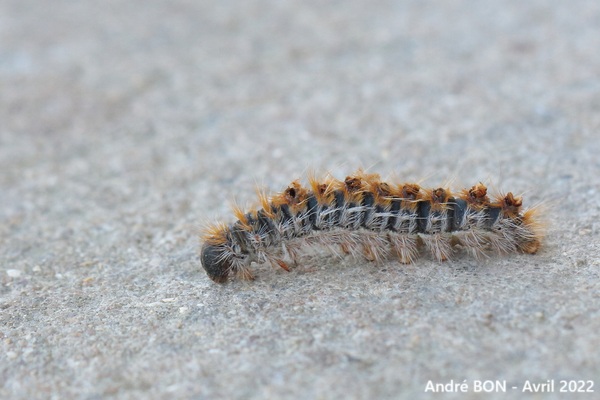
| Pine Processionary (Thaumetopoea pityocampa (Denis & Schiffermüller, 1775)) |

|
|
Scientific name: Thaumetopoea pityocampa (Denis & Schiffermüller, 1775) Common name: Pine Processionary French name: Processionnaire du pin Order: Lepidoptera Suborder: Heterocera Family: Notodontidae Subfamily: Thaumetopoeinae Wingspan: 31 to 39 mm for males; 36 to 49 mm for females. Biotope: Pine forests but also environments with isolated pine trees, including in peri-urban or urban areas. Geographic area: North Africa, Middle East, Southern Europe, expanding northwards and reaching Belgium in 2024. Flight time: Late June to mid-August. The adults only live a few days because they do not feed. Number of generations : 1 (the development cycle can take 2 years at altitude and in the most northern regions). Caterpillar: In the final stage of development, it has orange bristles on its dorsal side on a black background. The flanks have long, light grey hairs. The ventral surface is yellow. The caterpillars grow in silken nests generally located at the top or at the end of the branches of the host tree. They leave the nest in characteristic processions to pupate in the ground. From the third stage of development, these caterpillars have stinging micro-hairs that they can project when they feel threatened. Host plant: Coniferous trees, mainly Pines and Cedars. |
Adult Pine Processionary moths have dull ash-grey forewings with three narrow, parallel black transverse bands. The veins are darker. The thorax is hairy. The wings of females are more rounded, somewhat lighter in colour and with less distinct transverse bands. The hindwings are white, edged with grey, and have a dark spot at the anal angle. The abdomen, orange in colour, is broad and cylindrical in the female. It is narrower in the male. The antennae are pectinate in both sexes but much more so in males. Oak Processionary moth (Thaumetopoea processionea) caterpillars have rows of orange spots and long grey hairs. Processions are rarely found on the ground. Adults have a dark band on their hindwings. |
| [To know more about the Pine Processionary] [Top] |

|
The procession must have been disrupted because this caterpillar was observed in isolation. |